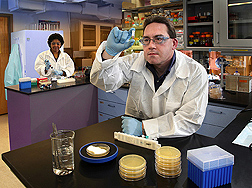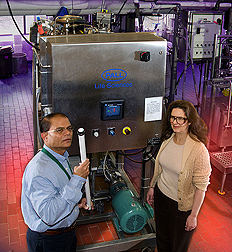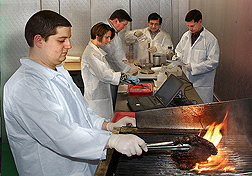New Methods for Ensuring Food Safety
Good news for fans of raw cookie dough. Researchers at ARS’s Eastern Regional Research Center (ERRC) in Wyndmoor, Pennsylvania, have filed a patent on technology that can further protect pasteurized liquid eggs from food safety threats. These threats include both naturally occurring spoilage bacteria and pathogens such as Salmonella enteritidis, the primary cause of egg-related foodborne illness in the United States. The technology has also been successfully applied to milk.
But don’t go running for that dough just yet. The U.S. Food and Drug Administration (FDA) still cautions against consuming any raw, unpasteurized eggs or products that contain them.
Despite adherence to pasteurization protocols prescribed by the U.S. Department of Agriculture, illnesses related to consumption of raw egg products still occur. About 40,000 cases of salmonellosis are reported in the United States each year. The new ARS technology, developed by ERRC scientists Sudarsan Mukhopadhyay, Peggy Tomasula, and John Luchansky, may help reduce that number.
“Current pasteurization technology is not adequate to remove all pathogens effectively from egg products,” says Tomasula, research leader of the ERRC Dairy Processing and Products Research Unit. “Though pasteurization eliminates heat-sensitive pathogens, some heat-resistant microorganisms can survive and spoil liquid egg whites.”
Consumers can avoid illness by properly handling and cooking eggs before consumption. But Tomasula, along with lead scientist Luchansky of the Microbial Food Safety Research Unit and chemical engineer Mukhopadhyay, has found that new technology can compensate for the shortcomings of thermal pasteurization.
The technology, called “crossflow microfiltration membrane separation” (CMF), removes more pathogens than thermal pasteurization does. And it does so without affecting the eggs’ ability to foam, coagulate, and emulsify—meaning that CMF-treated eggs could be safely substituted for pasteurized eggs in products where those characteristics are desired, such as angel food cake and mayonnaise. In a pilot-scale study, CMF was shown to remove about 99.9999 percent of inoculated S. enteritidis from unpasteurized liquid egg whites.
The technology can also be used to remove Bacillus anthracis spores from egg whites. This finding adds to previous work in which ERRC researchers used CMF to remove 99.9999 percent of B. anthracis spores inoculated into fluid milk. Microfiltration can also protect milk from more common bacterial pathogens, potentially extending its shelf life.
Though effective in its own right, CMF works best when treated as an accompaniment to pasteurization, not a replacement for it, says Tomasula. Combining the two processes significantly reduces the pathogen load.
Plague Defense
Using antibody- and DNA-based technology, ARS researchers in the ERRC Microbial Biophysics and Residue Chemistry Research Unit have developed a variety of methods for targeting dangerous pathogens in food. They’ve used these technologies to detect foodborne pathogens such as Escherichia coli O157:H7, Salmonella, and Listeria monocytogenes. Recently, microbiologist George Paoli and his colleagues have applied some of the same detection techniques to Yersinia pestis, the bacterium that causes bubonic plague.
“Many methods used to detect more common foodborne pathogens can be extended or modified for detecting organisms that are a concern with respect to food safety,” Paoli says.
The biological makeup of individual bacterial species varies considerably. Though the methods used to detect them are similar, they have to be altered to suit specific pathogens. Because antibodies bind to specific targets, antibody-coated immunomagnetic beads (IMBs) can be used to target and remove specific pathogens. The trick to IMB technology is finding an antibody that attaches to one, and only one, target—for example, a Y. pestis antigen. Paoli and his colleagues have developed IMBs to capture Y. pestis, and preliminary tests in milk samples have been successful.
In the early stages of testing the IMB technology, ERRC scientists found that their beads could pick Y. pestis out of a food mixture, but they also captured Staphylococcus aureus. Further research showed that the binding of S. aureus to the IMBs could be overcome by plating on media that were selective for growth of Yersinia. Use of these plates, along with the IMBs, significantly reduces the danger of false-positive results in samples that might also contain S. aureus.
The team is also using genetic methods that rely on a common DNA test known as the “polymerase chain reaction,” or PCR. The group has developed PCR-based methods to detect Y. pestis and differentiate it from other foodborne bacteria, including two closely related Yersinia species, Y. enterocolitica and Y. pseudotuberculosis. They have also developed a PCR method that targets genes related to the virulence of Y. pestis. This test could be used to determine a particular strain’s potential public health impact.
The scientists are currently working to combine the different areas of this research—the IMB detection, microbiological plating media, and genetic detection and typing of Y. pestis—to develop a complete set of tools for detection of Y. pestis in food, as part of a holistic approach to food security.
Warming Up to Food Security
The likelihood of B. anthracis or Y. pestis entering the U.S. food supply is very small—significantly smaller than the relatively low risk of contamination by Salmonella or other naturally occurring pathogens. Should that remote possibility occur, however, one of the easiest, most effective food safety tools—heat—lies in the hands of the consumer.
Previous ERRC studies have established and validated the use of thermal and nonthermal technologies to reduce the risk of foodborne pathogens. Luchansky and colleagues Vijay Juneja and Anna Porto-Fett recently led studies in which they applied thermal technology to ground beef inoculated with B. anthracis and Y. pestis—with encouraging results.
Patties made from inoculated ground beef were cooked on an open-flame gas grill and a “clam-shell” style electric grill. Both models are commonly used by consumers and the food industry. In both studies, the scientists found that cooking the ground beef on commercial grills, at the heat and time levels recommended by USDA and FDA, noticeably reduced the overall levels of both pathogens on or in the meat.
Research efforts like these ensure that U.S. consumers and food-industry professionals have the most advanced technology and information available to protect against potential pathogen threats.—By Laura McGinnis, Agricultural Research Service Information Staff.
This research is part of Food Safety, an ARS national program (#108) described on the World Wide Web at www.nps.ars.usda.gov.
To reach the scientists mentioned in this article, contact Laura McGinnis, USDA-ARS Information Staff, 5601 Sunnyside Ave., Beltsville, MD 20705-5129; phone (301) 504-1654, fax (301) 504-1486.
"New Methods for Ensuring Food Safety" was published in the May/June 2009 issue of Agricultural Research magazine.









